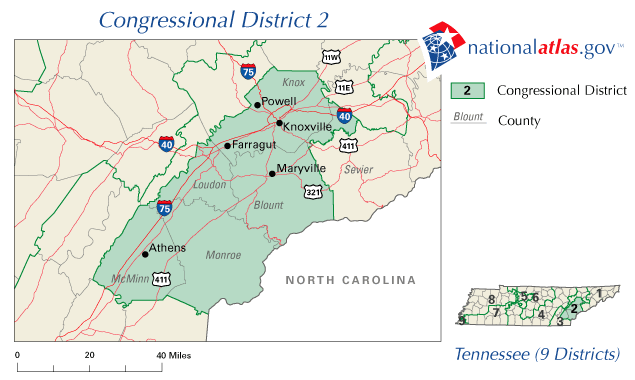- Tennessee's 2nd congressional district
Infobox U.S. congressional district
state = Tennessee
district number = 2
image width = 350
image caption =
representative = Jimmy Duncan
party = Republican
english area =
metric area =
percent urban =
percent rural =
population = 632,143
population year = 2000
median income = 36,796
percent white = 90.7
percent black = 6.3
percent asian = 1.0
percent native american = 0.3
percent hispanic = 1.3
percent other race = 0.1
percent blue collar =
percent white collar =
percent gray collar =
cpvi = R+11The 2nd congressional district of Tennessee is a congressional district in
Tennessee . It currently includes the east central part of the state.The district is based in
Knoxville , and is largely coextensive with that city's metropolitan area. It includes most of that city's suburbs, such as Powell, Farragut and Maryville. It extends into the northern fringes of theChattanooga area, including Athens.The 2nd is one of the safest districts in the nation for the Republican Party. No Democrat has represented the district since 1855, and Republicans (or their antecedents) have held the district continuously since 1859. It was one of only two districts in Tennessee (the other being the neighboring 1st district) whose congressmen did not resign when Tennessee seceded from the Union prior to the Civil War.
Because most of its residents supported the Union over the Confederacy, the people almost immediately identified with the Republicans after hostilities ceased. Much of that sentiment was derived from the region's economic base of small-scale farming, with little or no use for
slavery ; thus, voters were mostly indifferent or hostile to the concerns ofplantation owners and other landed interests farther west in the state, who aligned themselves with the Democratic Party. This loyalty has persisted to this day.From the end of Reconstruction through the
1950s , the Republican Party in Tennessee was more or less nonexistent outside ofEast Tennessee . However, in the1960s conservative Democratic whites, especially in suburban Memphis andNashville , began voting for the likes ofBarry Goldwater ,Howard Baker (whose father and stepmother were representatives from the 2nd in the 1950s and 1960s), andRichard Nixon . Traditional East Tennessee Republicans, who held most if not all the conservative views of those from the other two grand divisions of the state, began welcoming them into their party, and have worked more or less together as a coalition ever since.A few pockets of Democratic voters exist in Knoxville, which has occasionally elected Democratic mayors and sends a few Democrats to the state legislature. However, they are no match for the overwhelming Republican tilt of the rural areas, the Knoxville suburbs, and most of Knoxville itself.
Coal miner s in the far northern fringe of the district also supported Democrats from the 1930s onward, but nearly all of the coal-mining region was drawn into the 4th district after the 1980 Census.Representatives
Wikimedia Foundation. 2010.
